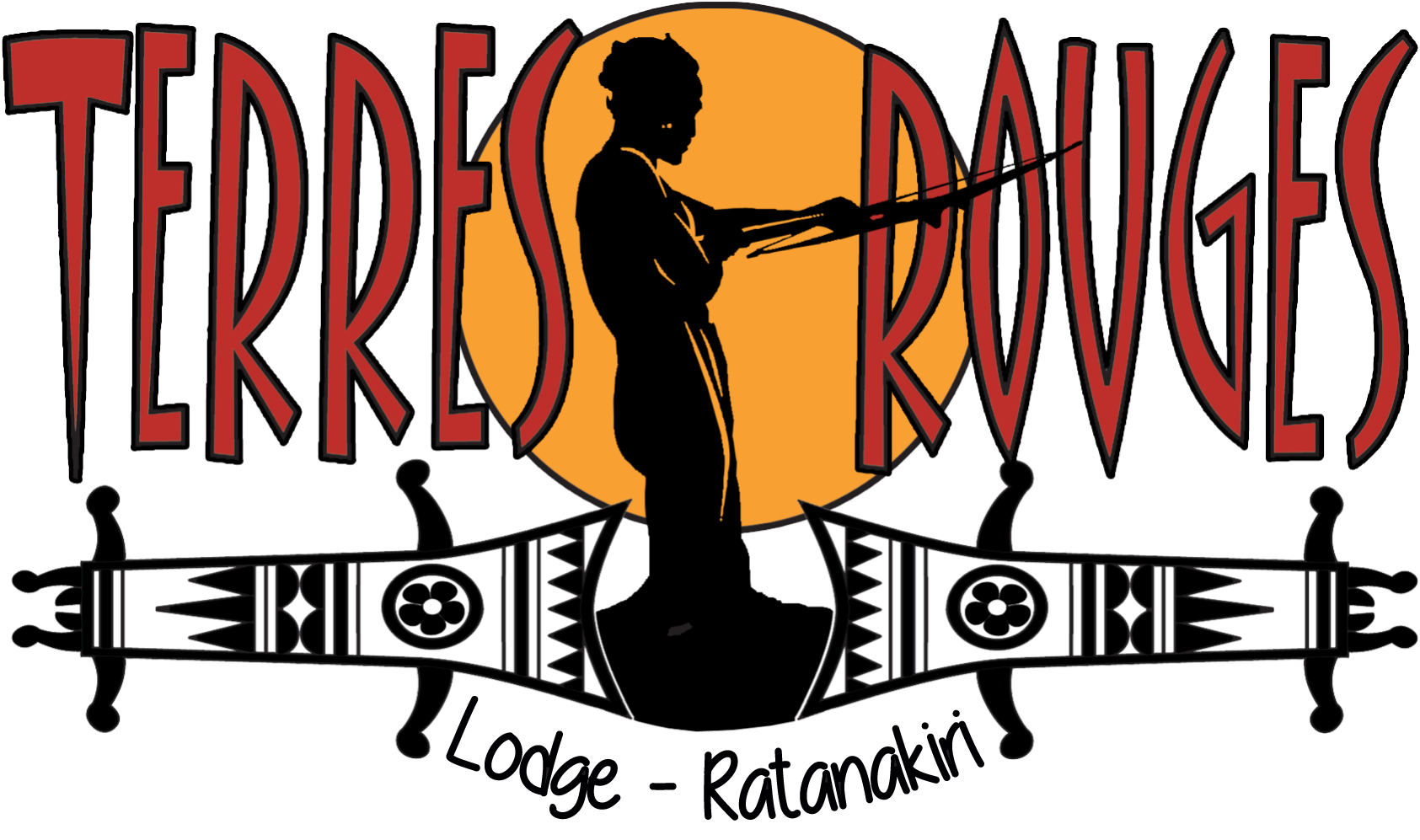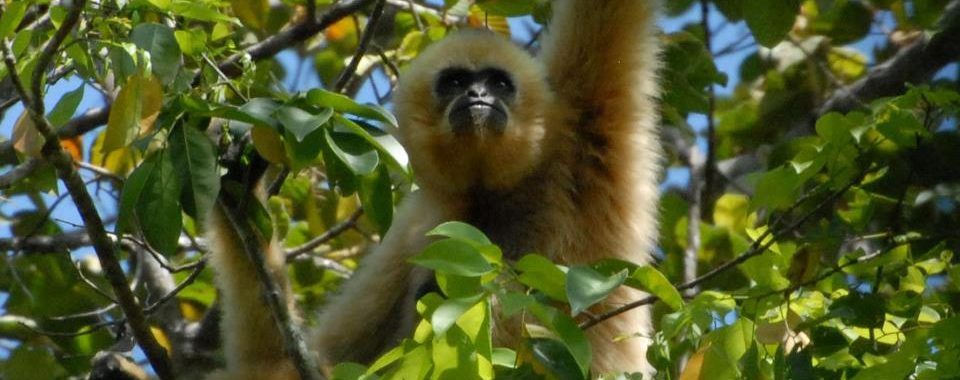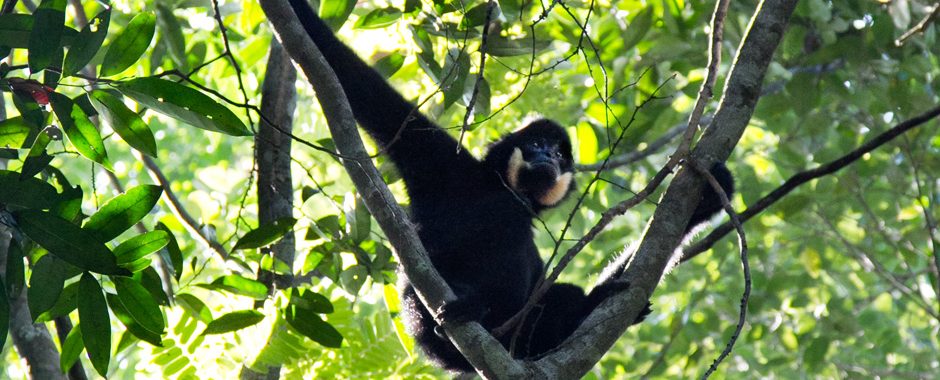GIBBONS SAFARI
Cambodia’s first ever gibbon experience
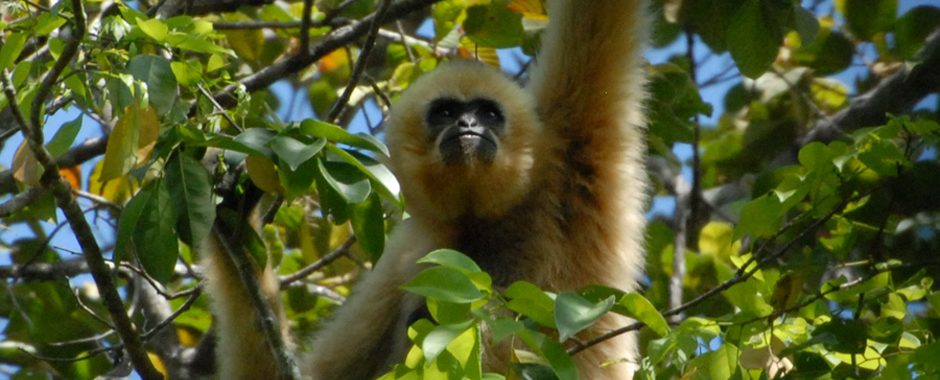
A simply amazing experience for wildlife lovers to see the incredibly rare ‘northern yellow-cheeked gibbons’ in their natural habitat in the Ratanakiri province of Northeast Cambodia. This rare and endangered species of gibbon was only discovered in 2010 with an estimated 500 groups at the site, this is the largest known population in the world! In the west of Ratanakiri province, lies a luscious forest called Veun Sai-Siem Pang Conservation Area. This protected 550 square km area is home to this extremely important gibbon population, as well as a host of other endangered species. ‘See Cambodia Differently’ in partnership with ‘Terres Rouges Lodge’, ‘Conservation International’ and the local communities have put together an exclusive two day, one night gibbon spotting trek, the first of its kind in Cambodia. A unique experience for enthusiastic wild life spotters and those who are interested in biology and nature conservation. Only very small groups of between 2-6 visitors are allowed to visit the site making this an extremely special opportunity indeed.
Exclusively limited to only 462 people per year.
The northern yellow-cheeked gibbon
Based on population surveys conducted in 2009, there are an estimated 500 groups of northern yellow-cheeked gibbons at the site; each group consists of two adults and their juvenile offspring. The gibbon species in Veun Sai-Siem Pang Conservation Area was discovered for the very first time in 2010 in a multinational collaborative effort by primatologists throughout the region with data contributions from Conservation International researchers at the site. The (VSSPCA) was extremely important to the discovery of the species and genetic material recovered from the faeces of the wild gibbon group helped demonstrate that this indeed was a new species. The discovery of new apes are incredibly rare and the opportunity to see this species in their natural habitat is all the more unique. This new species, Nomascus annamensis, has not yet been assessed for is threat status by the World Conservation Union (IUCN Red List), how-ever it is extremely likely that they will be listed as Endangered. At the site it is possible to see and follow a family group of an adult male, adult female, a sub-adult, a juvenile and an infant. Gibbons are monogamous with groups generally consisting of 2 adults and up to 3 offspring. When the offspring reach maturity at around 7 to 10 years they leave the group to find a mate in another part of the forest to raise their own offspring. Gibbons are fiercely territorial of their areas of the forest and make their claims known through ritualistic vocalizations. The gibbons live in perfect harmony with the Kavet people who consider the gibbons as extremely important; they are not hunted but respected and share the jungle together. This in stark contrast with many other areas in South-east Asia, where gibbons and other primates are persecuted and hunted for bushmeat, for their perceived medicinal properties, or for the trade in pets.
This is why such a healthy population exists in this area and is a testament to the importance of the site and its relatively untouched nature. We hope that showing that gibbons and the natural environment can be valuable maintained as they are will help preserve this species and this area for generations to come.
Veun Sai-Siem Pang Conservation Area
Situated in the far northeast of Cambodia, the forests of Veun Sai-Siem Pang Conservation Area (VSSPCA) form part of a large protected area network that is home to many indigenous peoples and threatened wildlife. Bordering the Virachey National Park, the luscious forest of VSSPCA which covers an area of 55,000 hectares of lowland evergreen and semievergreen forest. High in biodiversity and species density these forests are home to eight of the sixteen most threatened terrestrial species in Cambodia and part of the largest known population of northern yellow-cheeked gibbons in the world.
Although rich in natural resources, the northeast is one of the poorest areas in Cambodia. Home of several indigenous hill tribes, small settlements of mainly Kavet people that are dotted around this forest, which is bordered by small agricultural fields.
This area is one of the very few left in Cambodia that is almost pristine. Small streams and rocky creeks meander through dense vegetation and grassy savanna contrasts with dense jungle. In addition to the gibbons, other threatened primates including the red-shanked douc langurs, silvered langurs and pygmy loris can be seen if you know where to look. The site is also home to several impressive mammals like Asiatic black bears, sun bears, gaur (wild cattle), dhol (wild dogs) and various jungle cats such as the leopard and clouded leopard who feed on the site’s wild pigs and deer. Highly threatened birds such as Cambodia’s national bird, the giant ibis, of which only a few hundred may remain in the world, and the white-winged duck still persist here, as do the stunning greater hornbill and well over 100 other bird species so far recorded. Amazing insects, amphibians and reptiles, possibly including the critically endangered Siamese crocodile also live on here in this beautiful wilderness.
Local Communities
The Veun Sai area has supported the traditional livelihoods of many groups of indigenous people for centuries. The local communities living in and around the forests represent a diversity of cultures including Brao, Laos, Mon-Khmer, Kavet and Kinh all with their own cultural and linguistic traditions. The local community are co-beneficiaries of funds raised through Gibbon Spotting Cambodia. Developed and supported by Conservation International, the Community-based Ecotourism Management Team, which is made of democratically elected local community members, receives funds from entrance fees and services provided through our tours and these funds are used in totality for the community’s benefit.
Money is spent on improving the ecotourism facilities, conservation activities such as funding patrol work by community members to protect the natural resources on which they rely and development projects, as determined collectively by the communities around Veun Sai-SiemPang Conservation Area.
We are working together towards continuous protection of this area to preserve the natural beauty of Ratanakiri while meeting the needs of the local indigenous community.
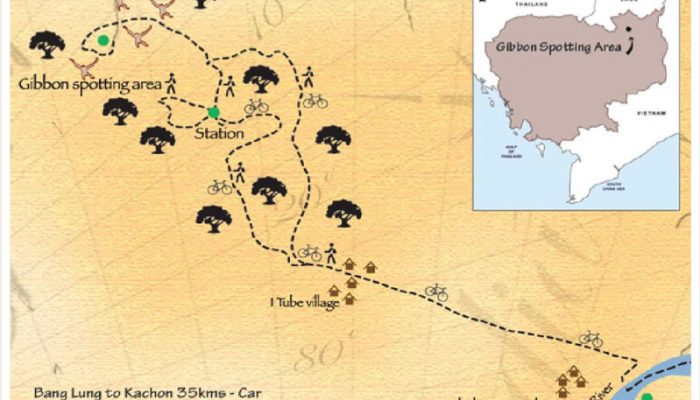
Trek details
Evening briefing: At 7pm we will meet at the restaurant for a trek briefing. It is the first opportunity for everyone to meet the people on their trek and to run over the final details so everyone knows what to expect. All participants then sign the consent form and are free to enjoy their last night before the adventure begins.
Day 1: You will be picked up from the hotel at 8am and depart by car from Ban Lung at 8:30am and travel 35 km north to Kachon village approximately 45 minutes away. In Kachon, a boat will be waiting to take you 12 km, again approximately 45 minutes downstream on the Sesan River to Veun Sai town. On this journey you can observe the nature on the riverbank and the daily activities of the people who live along the river. In Veun Sai town we will board local motorcycles to travel about 30 minutes to I Tub village, a Laotian community approximately halfway to the Veun Sai-Siem Pang Conservation Area station. Once in I Tub, we will take a short break for lunch and meet with a member of the Community-based Ecotourism Team. After lunch we continue to the station by motorbike along a forest path, we might see tracks and signs of some of the local wildlife such as the claw marks of the sun bear on the tree trunks, or footprints of deer and other species as well as local birds. We will ride the majority of the way but in order to get a good look at our surroundings we will hike in some parts. At around 3pm we will arrive at the gibbon research station where you will be introduced to the station chief, scientists and researchers (if there are any around), your gibbon guide and shown around the camp. You then have time to relax and make yourself comfortable before walking to the nearby savannah for a spot of bird watching; before sitting down to an early dinner at 6:45pm
Day 2: Today we rise early at 3:15am because the gibbons wake up with the sun and call to mark their territory as soon as dawn breaks. At 4am, whilst it is still dark we following a small trail to the protected gibbon area about 45 minutes away to make sure that we are there in time to hear their call. We then reach the edge of a grassy savannah and wait for the call of a certain gibbon family, currently the only group that accepts people in their presence. The different groups start to call (sing) at around sunrise with some calls carrying up to 2km. Once the habituated groups of gibbons starts to sing, the gibbon guide will try to locate them in the forest as fast as possible and he will guide us to the spot so we can watch them as they go about their morning activities in the tree canopy. In some cases they let you come very close –less than 15 meters – which provides an excellent opportunity to take pictures.
This is a special time as the gibbons can travel quickly in the trees and leave in a split second, anytime they want. Once they do, it can be very difficult for us to find them again, however the group can often be followed for a couple of hours throughout the forest.
After the gibbon spotting we head back to the station for brunch at about 10:30am. We then pack up and get ready to leave. We follow a different path through the jungle and head back to I Tub village. Again, some parts we will cycle some we will walk. On the way we visit a Chinese and Laos settlement and take a short walk around the village. It’s a nice idyllic village with friendly people and on certain days you will be able to witness traditional local weaving. We then continue back to Veun Sai town, cross the Sesan River by a small ferry, before stopping off for lunch at a restaurant that boasts a beautiful view of the river and its banks. Our journey has now come to an end and we are picked up by car and travel back to Ban Lung arriving at approximately 3pm.
Gibbon Spotting Prices
N$400 per person for 2 people $300 per person for 3 to 6 people
Please Note:
We only run tours of between 2 and 6 people per group as we look to control the risk of the human impact as well as optimizing your chances of viewing the gibbons. If you are an individual we will try and pair you up with another group. If this is not possible and you still wish to see the Gibbons then we will have to charge you the rate of two people.
We do run private groups in which case you will be charged as if you were a group of 6 people.
We only run treks from the 1st November to the 18th June each year.
How to Book
In order to make a booking we require full payment 30 days prior to the departure of your gibbon trek. If at any stage to the lead up to the trek that you have to cancel we will retain 30% of the total cost of the trek.
The only method of payment that we are able to accept at this current time is via bank transfer. All fees incurred by your bank for such transfers is not the responsibility of ‘the organizers and invoices must be paid in full.
Additional information
Gibbons
The gibbons are wild animals and there are no guarantees that you will see the gibbons on every trek. Based on previous sightings, the chances are about 70%, increasing slightly in the dryer months as the gibbons call more frequently in the mornings, which is how we locate these groups. You can expect to get within 20 meters of the gibbons and if you are handy with a camera, expect some great photos. It is often possible to follow the gibbons for several hours as they go about their morning activities; swinging through the trees and feeding on fruits and leaves in the forest.
The Veun Sai-Siem Pang Conservation Area Station
The station is where the scientists live while they conduct research. Armed government law enforcement agents also live at the station and are based there to patrol the Veun Sai Siem Pang Conservation Area and to prevent illegal poaching and logging, offering additional security as well as protecting the gibbons. We will be based here while on the trek and are the guests of the station staff and must respect the area, the station staff, their rules and the work that they do.
Facilities
The station provides basic facilities such as a field kitchen, accommodation and sanitation. While at the station hammocks with attached mosquito nets will be provided for you to sleep in. At the moment, these have been set up in a basic solid structure for shelter from the elements. However we look to continuously improve the facilities at the centre for our visitors. There is a building used by the community-based ecotourism management team for storage and where you will be taking meals.
Food is prepared on a wood fire in the designated kitchen area. The community-based ecotourism management team has also built a small traditional shelter with a thatched leaf roof and table and chairs. Shared with station staff and researchers, there are two bathroom stalls with freshwater for showering and squat toilets.
Equipment provided during the trek:
Backpacks, hammocks, blankets, rain poncho’s (wet season), aluminum water bottles, cutlery, cups, plates, bed sheets, towels, toilet paper, soap and torches or head- lamps for the night walk.
Suggested items to pack
2 Sets of Clothing 1) A set of neutral-coloured clothes of natural fibers (cotton) for the trek and gibbon spotting; Long trousers, long-sleeved shirt, walking boots, walking socks and a hat.
2) A clean set of clothes for the night; Long or short trousers (depending on the season and temperature), long sleeved shirt, fleece jacket or sweater, sandals or flip flops and a spare pair of socks. In addition we suggest only bringing a limited number of personal items with you, as whatever you bring you will have to carry, we suggest; some personal toiletries, soap, sun cream, sun glasses, insect repellent, swim suit, travel towel, torch or headlamp, binoculars and a personal first aid kit including any necessary medication such as anti malaria pills or other. As well as a small day-pack to carry your camera etc…
*Please also see the cultural section under the code of conduct as to respect the people you will come in contact with during the trek.
Meals
The food on the trek is good, fresh and nutritious. We serve a western breakfast of homemade bread with eggs, jam, coffee and tea. Lunch and dinner consist of rice or noodles, followed by fresh fruit. With the exception of vegetarian meals, all food will be prepared for every guest in the same way. Please note that there is no possibility of cooking different food for individuals.
Weather
Cambodia experiences a dry season and a wet season. The dry season occurs each year from about November to July. The wet season comprises the remainder of the year, with rain and flooding occurring in varying degrees of intensity. Hence we will only be running treks for 9 months each year. During this period we plan to take back to back treks however at certain times it can be difficult to bicycle on slippery tracks. If the weather is particularly bad then there could be some blackout- dates during this period. We will endeavor to take treks with limited interruptions.
Cancelation Policy
‘Gibbon Spotting Cambodia’ reserves the right to cancel treks at any time. It is extremely rare that this will happen and we will try and give you as much warning as we can. We will also try and rearrange your trek to fit around your existing Cambodian travel plans. The decision to cancel a trek will rest with the organizers and will be for reasons of safety only. If a trek is cancelled then all monies will be refunded.
Insurance and Safety
All clients will be asked to sign a Consent, Assumption of Risk and Release form before being allowed to participate.
We also insist for your safety that all clients have suitable insurance cover, including helicopter evacuation in the eventuality that you may need to be airlifted out of the jungle if an accident occurs. Clients should also be advised that like much of rural Cambodia, the site has mosquitoes, which may carry malaria.
Malaria can be potentially fatal if contracted and as such clients are advised to seek medical advice concerning malaria avoidance prior to visiting the site. Avoiding being bitten by mosquitoes is the most effective way to avoid malaria. Many travelers to Cambodia also choose to take malarial prophylaxis, medication, which prevents malaria in the case of infection. If you become ill after leaving the site, be aware that you may have malaria and need to seek immediate medical advice.
Group Sizes (Private Groups)
We are only running tours of between 2 and 6 people per group as we look to control the risk of human impact as well as optimizing your chances of viewing the gibbons. If you are an individual we will try and pair you up with another group. If this is not possible and you still wish to see the Gibbons then we will have to charge you the rate of two people.
We do run private groups in which case you will be charged as if you were a group of 6 people.
Age Limit (Fitness Level)
The minimum age of visitors to the gibbons is 15 years old unless the parent or guardian of the child gives consent by signing the ‘Consent, Assumption of Risk and Release Form’ on their behalf. There is no maxi- mum age limit, trekking in the Veun Sai-Siem Pang Conservation Area can be physically demanding and we request that visitors are in sufficient physical condition to endure hiking in forests without trails and in hot humid conditions. Please carefully consider your decision to trek as health services near the VSSPCA are limited.
Code of Conduct
We operate our treks under a strict code of conduct and all clients traveling to the area must be aware of these rules and behave and conduct themselves accordingly.
Les gibbons sont sauvages nous ne pouvons garantir que vous en verrez ; les chances sont environ de 70%, elles sont plus élevées dans les mois les plus secs quand les gibbons appellent plus frequemment, ce qui permet de localiser les groupes. On peut les approcher à 20 m ce qui permet de belles photos. Il est souvent possible de suivre les gibbons lors de leurs activites du matin pendant qu’ils se balancent d’arbre en arbre et mangent des fruits et des feuilles dans la forêt.
